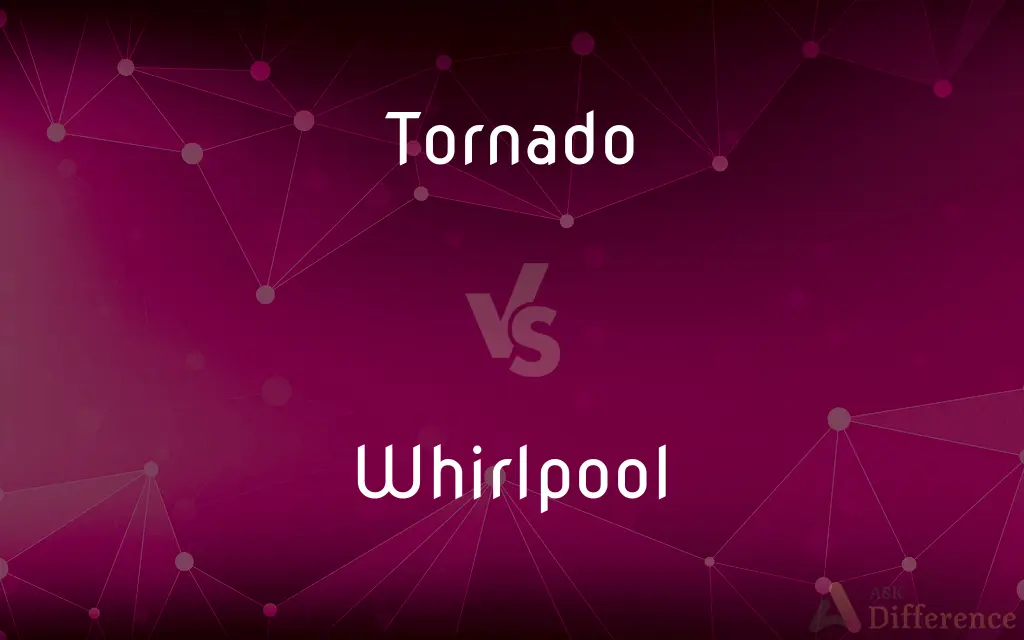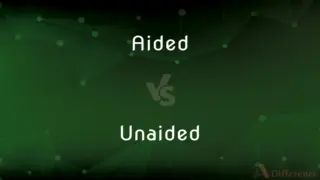Tornado vs. Whirlpool — What's the Difference?
By Tayyaba Rehman & Urooj Arif — Updated on April 1, 2024
A tornado is a violently rotating column of air connected to both the surface of the Earth and a cumulonimbus cloud, while a whirlpool is a swirling body of water produced by the meeting of opposing currents.

Difference Between Tornado and Whirlpool
Table of Contents
ADVERTISEMENT
Key Differences
A tornado forms under certain conditions, primarily during severe thunderstorms, where warm, moist air meets cold, dry air, leading to the development of a supercell that can spawn one or more tornadoes. In contrast, whirlpools occur in aquatic environments when opposing currents meet, or water flows through a narrow passage, creating a vortex.
Tornadoes are measured on the Enhanced Fujita scale, which classifies their intensity based on the damage they inflict on human-made structures and vegetation. On the other hand, whirlpools do not have a standardized scale of measurement, as their size and strength can vary greatly, but their intensity is often described by their ability to pull objects, including boats, into their center.
The impact of tornadoes is primarily observed on land, where they can cause significant destruction to buildings, vehicles, and landscapes, often resulting in loss of life. Whirlpools, while potentially dangerous to swimmers and boats, generally pose less threat to human life and property on a large scale, with their effects confined to water bodies.
While both phenomena are natural occurrences resulting from specific environmental conditions, tornadoes are more closely monitored and studied by meteorologists due to their potential for widespread damage and danger to communities. Whirlpools, though fascinating and sometimes hazardous, are more of interest to oceanographers and mariners.
The visual appearance of tornadoes and whirlpools also differs significantly. Tornadoes can appear as funnel-shaped clouds ranging from transparent to dark, depending on the debris they carry, whereas whirlpools are seen as swirling water, sometimes forming a visible funnel or depression in the water surface.
ADVERTISEMENT
Comparison Chart
Nature
Air column connected to cumulonimbus cloud and ground.
Water vortex caused by opposing currents.
Formation
During severe thunderstorms from specific atmospheric conditions.
When water currents meet or flow through narrow spaces.
Measurement Scale
Enhanced Fujita scale based on damage.
No standardized scale; described by pulling strength.
Primary Impact
Land, causing damage to structures and vegetation.
Water bodies, potentially hazardous to boats and swimmers.
Interest to
Meteorologists for study and weather prediction.
Oceanographers and mariners for navigation and study.
Visual Appearance
Funnel-shaped cloud, ranging from transparent to dark.
Swirling water, sometimes forming a visible funnel.
Compare with Definitions
Tornado
Causes widespread destruction on land.
The tornado's passage left a trail of devastation across the town.
Whirlpool
Appears as swirling water, sometimes creating a depression.
The whirlpool's center was visibly deeper than the surrounding water.
Tornado
Subject of meteorological study and prediction.
Meteorologists issued a tornado warning based on radar data.
Whirlpool
Mainly affects water navigation and aquatic life.
Swimmers are advised to avoid the area due to the whirlpool's risk.
Tornado
Often appears as a funnel-shaped cloud.
The tornado's funnel touched down near the river, visibly darkened by debris.
Whirlpool
Intensity can range from mild to very strong.
The whirlpool near the strait is known for its dangerous pull.
Tornado
Classified by the Enhanced Fujita scale.
The tornado was categorized as an EF3, indicating significant damage.
Whirlpool
Analyzed for navigation and safety in marine studies.
Mariners study whirlpool locations to ensure safe passage.
Tornado
A violent air column connected to the cloud and ground.
The tornado destroyed homes and uprooted trees along its path.
Whirlpool
A swirling body of water formed by opposing currents.
The boat struggled to navigate the powerful whirlpool.
Tornado
A tornado is a violently rotating column of air that is in contact with both the surface of the Earth and a cumulonimbus cloud or, in rare cases, the base of a cumulus cloud. The windstorm is often referred to as a twister, whirlwind or cyclone, although the word cyclone is used in meteorology to name a weather system with a low-pressure area in the center around which, from an observer looking down toward the surface of the earth, winds blow counterclockwise in the Northern Hemisphere and clockwise in the Southern.
Whirlpool
A whirlpool is a body of rotating water produced by opposing currents or a current running into an obstacle. Small whirlpools form when a bath or a sink is draining.
Tornado
A violently rotating column of air extending from a cumulonimbus cloud to the ground, ranging in width from a few meters to more than a kilometer, with destructive winds up to 510 kilometers (316 miles) per hour or higher. Tornadoes are typically associated with a funnel cloud pendant from a storm's wall cloud, often extending to the bottom of the tornado.
Whirlpool
A rapidly rotating current of water; a vortex.
Tornado
A violent thunderstorm in western Africa or nearby Atlantic waters.
Whirlpool
Something, such as a situation, that is confusing or tumultuous and is easy to be drawn into or difficult to get out of
Was sucked into a whirlpool of despair.
Tornado
A whirlwind or hurricane.
Whirlpool
A bathtub or pool having jets of warm water that can be directed toward a body part as for therapeutic purposes.
Tornado
(meteorology) A violent windstorm characterized by a mobile, twisting, funnel-shaped cloud.
A tornado is a rotating column of air.
Whirlpool
A swirling body of water.
A whirlpool is an instance of a vortex produced by ocean tides, or by a hole underneath where the water would drain out, such as in a bathtub.
Tornado
A violent whirling wind; specifically (Meteorol.), a tempest distinguished by a rapid whirling and slow progressive motion, usually accompaned with severe thunder, lightning, and torrents of rain, and commonly of short duration and small breadth; a small cyclone.
Whirlpool
A hot tub, jacuzzi.
Tornado
A localized and violently destructive windstorm occurring over land characterized by a funnel-shaped cloud extending toward the ground
Whirlpool
Turmoil, or agitated excitement.
Tornado
A purified and potent form of cocaine that is smoked rather than snorted
Whirlpool
(intransitive) To spin or swirl like the water in a whirlpool.
Whirlpool
An eddy or vortex of water; a place in a body of water where the water moves round in a circle so as to produce a depression or cavity in the center, into which floating objects may be drawn; any body of water having a more or less circular motion caused by its flowing in an irregular channel, by the coming together of opposing currents, or the like.
Whirlpool
A sea monster of the whale kind.
The Indian Sea breedeth the most and the biggest fishes that are; among which the whales and whirlpools, called "balænæ," take up in length as much as four . . . arpents of land.
Whirlpool
A powerful circular current of water (usually the resulting of conflicting tides)
Whirlpool
Flow in a circular current, of liquids
Common Curiosities
Where do whirlpools commonly occur?
Whirlpools commonly occur in narrow straits, at the base of waterfalls, and where tidal conditions are right.
Are there famous whirlpools?
Yes, the Corryvreckan off Scotland and the Naruto whirlpools in Japan are well-known.
Can whirlpools sink ships?
Large and powerful whirlpools can potentially sink small boats, but large ships are usually safe from being pulled under.
What causes a tornado?
Tornadoes are caused by severe thunderstorms where warm, moist air meets cold, dry air, leading to powerful rotating updrafts.
How are tornadoes predicted?
Meteorologists use radar, satellite data, and atmospheric condition models to predict tornado formation and issue warnings.
What is the difference in damage potential between tornadoes and whirlpools?
Tornadoes can cause extensive damage over a broad area on land, while whirlpools pose a localized threat primarily to water navigation.
Can a tornado form over water?
Yes, tornadoes that form over water are called waterspouts.
Do whirlpools appear suddenly?
Whirlpools can appear suddenly or be permanent features, depending on their cause.
Can tornadoes occur in any country?
Tornadoes can occur in many countries, especially those in temperate regions, but are most common in the United States.
How long do tornadoes last?
Tornadoes can last from a few seconds to over an hour, but most last less than 10 minutes.
Is it possible to escape a whirlpool?
Small boats can sometimes escape a whirlpool by rowing perpendicular to the current, but escape depends on the whirlpool's strength and size.
How do whirlpools affect marine life?
Whirlpools can trap and disorient marine life but can also concentrate food, attracting fish.
What is the strongest type of tornado?
The strongest type of tornado is an EF5, which can cause incredible damage, including leveling strong framed houses.
What are the safety precautions for tornadoes?
Safety precautions include seeking shelter in a basement or interior room without windows, away from exterior walls.
What role do oceans play in tornado formation?
Oceans provide the moisture needed for the formation of thunderstorms, which can lead to tornadoes.
Share Your Discovery

Previous Comparison
Aided vs. Unaided
Next Comparison
Denial vs. TeaseAuthor Spotlight
Written by
Tayyaba RehmanTayyaba Rehman is a distinguished writer, currently serving as a primary contributor to askdifference.com. As a researcher in semantics and etymology, Tayyaba's passion for the complexity of languages and their distinctions has found a perfect home on the platform. Tayyaba delves into the intricacies of language, distinguishing between commonly confused words and phrases, thereby providing clarity for readers worldwide.
Co-written by
Urooj ArifUrooj is a skilled content writer at Ask Difference, known for her exceptional ability to simplify complex topics into engaging and informative content. With a passion for research and a flair for clear, concise writing, she consistently delivers articles that resonate with our diverse audience.














































